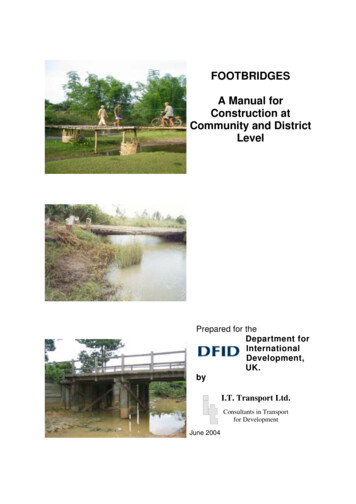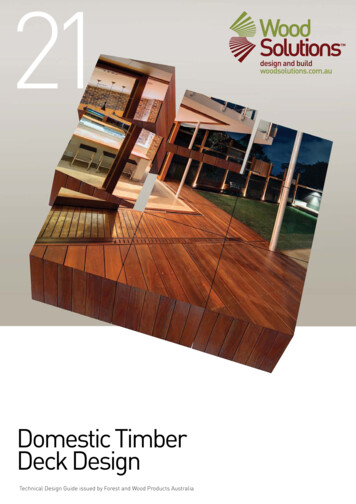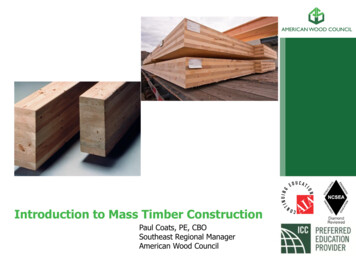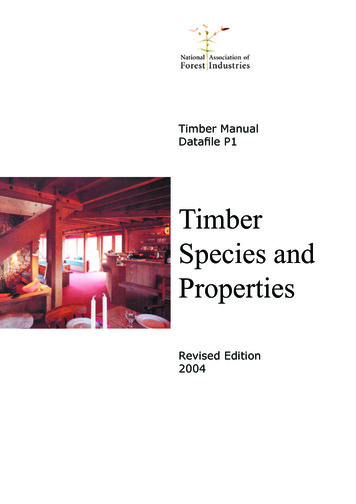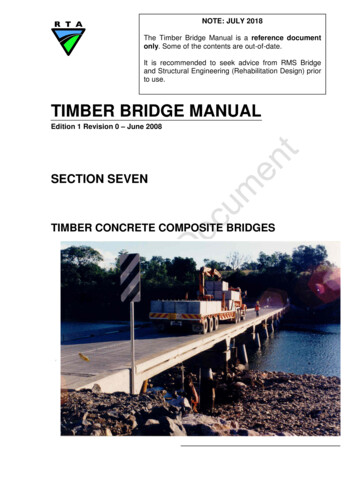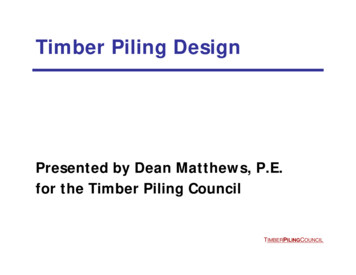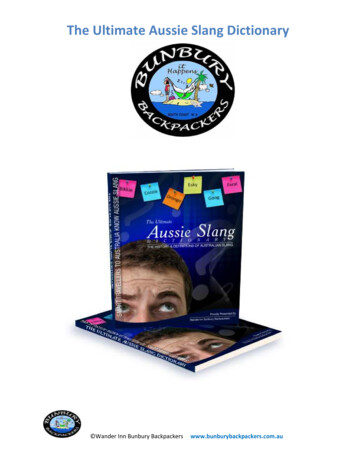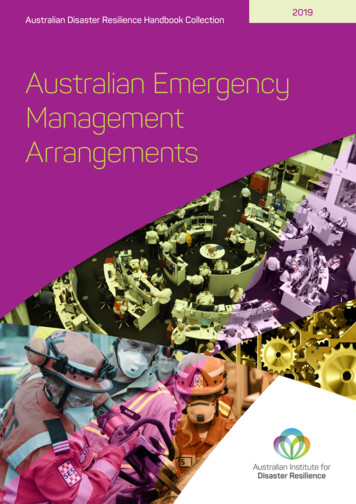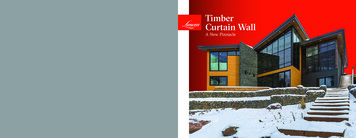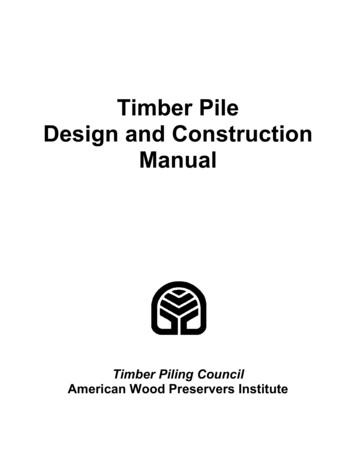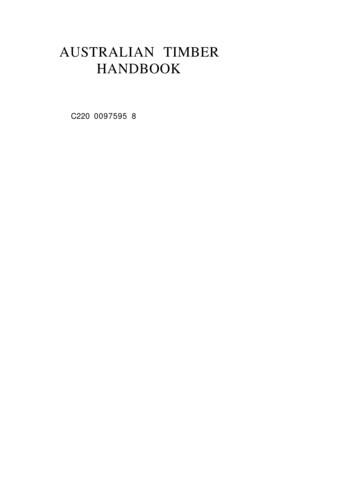
Transcription
AUSTRALIAN TIMBERHANDBOOKC220 0097595 8
AUSTRALIANTIMBERHANDBOOKNORMAN K. WALLISSponsored by The Timber Development Associations6 7 4 . 0 9 0 4 WALL031367-AWAL L 1 S f MOPMA N K.AUSTRALIAN T I M B E RHANDBOOK.0 207120536ANGUS AND R O B E R T S O N
First published in 1956 byANGUS & ROBERTSON LTD221 George Street, Sydney54 Bartholomew Close, London107 Elizabeth Street, Melbourne89 Anson Road, SingaporeRevised editions 1963, 1970 Timber Development Associations of AustraliaThis book is copyright.Apart from any fair dealingfor the purposes ofprivate study, research, criticism or review,as permitted under the Copyright Act,no part may be reproducedby any process without written permission.Inquiries should be addressed to the publishers.National Library of AustraliaCard Number & ISBN 0 207 12053 6 SRegistered in Australia for transmission by post as a bookPRINTED IN AUSTRALIA BY HALSTEAD PRESS, SYDNEY
PREFACEThe Australian Timber Handbook is designed to assist producers and users oftimber by submitting, in precise and practical form, the more importantfeatures affecting timber in its various stages of manufacture and use. Originally written by an experienced Australian timber man, Norman K. Wallis,with the special object of describing Australian timber practice, the Handbookwas first published in 1956.In that edition, acknowledgement of the co-operation of the C.S.I.R.O.,Division of Forest Products, the New South Wales Forestry Commission,Division of Wood Technology and the Timber Research and DevelopmentAssociation, London was recorded. Special mention was also made of Mr.C. A. Lembke, Editor of The Australian Timber Journal, who was responsiblefor the checking of proofs, the setting up and the format of the volume.A new revised edition, considerably enlarged to cover later developmentsin timber processing both in Australian States and overseas, was published in1963.Appreciation was there recorded for the assistance of Mr. John Moss, ofHicksons Timber Impregnation Co. (Aust.) Ltd., and Mr. Albert Cameron,of Lewis Berger & Sons (Aust.) Pty. Ltd., as well as those authorities mentioned in the Introduction, in the compiling of the original Handbook.There has been an increasing demand for copies since that time, and thestage was reached where it became impossible to obtain a copy anywhere inAustralia.The untimely death of the original author at the height of his career in1965 has left a serious gap in the ranks of professional men willing to devotethe better part of their lives to the study of timber and its best application tothe service of man.Born in 1900 in Sydney, Norman Arthur Kingsbury Wallis received hisinitial education at All Saints College, Bathurst, and studied Arts and Economics at Sydney University.His earliest association with the timber industry began in his father's business at Pyrmont. The business was originally founded by Norman's greatgrandfather in the early nineteenth century.Prior to the Second World War, he was a heavy cruiser yachtsman andowned the well-known yacht Wanderer. During the war he was a seagoingLieutenant Commander and finished the war on corvettes and frigates.On cessation of hostilities, Norman Wallis established new sources of timber supply in Malaya, Borneo and Sarawak on behalf of the timber industry.In the late 1940s he went to the Solomon Islands for the same reason.v
He was a foundation councillor and life member of T.D.A. and was President on five occasions. At the time of his death, Norman Wallis was Chairmanof the Timber Industry's Standards Committee.In order to continue to meet the needs of those requiring a basic knowledge of the properties and utilisation of timbers in Australia, the TimberDevelopment Associations decided that urgent publication of an up-to-datethird edition of the Handbook was necessary, and they have been responsiblefor a major portion of the effort in compiling this edition. The task of editingwas entrusted to Charles J. J. Watson, formerly of the Queensland Department of Forestry, an early Australian member of the International Associationof Wood Anatomists, and well-known in the timber field.The Associations again express their thanks to those Authorities who havegiven generous help toward the success of this new Handbook and to thosewho were acknowledged in earlier editions. Special mention is made of thetechnical officers of the Division of Forest Products, C.S.I.R.O., Melbourne,and of the Division of Wood Technology, New South Wales Forestry Commission, Sydney. Other essential material was supplied by the DirectorGeneral, Forestry and Timber Bureau, Canberra, and the Conservators ofForests in other States. The assistance of Mr. P. E. Marshall, B.Sc, formerlyOfficer in Charge of Seasoning, Division of Wood Technology, New SouthWales Forestry Commission is also acknowledged.The assistance of Mr. David Bubb, Director of the Timber DevelopmentAssociation (Queensland) and Mr. D. S. Jones, Development Engineer,Queensland Timber Board, is recorded with appreciation.N. K. GIRDLER, Director,Timber Development Association (New South Wales) Limited.vi
CONTENTSIntroductionixPart OneAUSTRALIAN TIMBERS AND THEIR CONVERSIONIThe Australian Timber Industry3IISystems of Measurement24IIIMethods of Sawing Logs36IVSawmill Equipment48Saws and Saw Fitting59Planing74VVIVIIVeneer,. Plywood, Blockboard, Particle board, andFibreboardVIII82Glues and their Uses107IXGlued Laminated Construction120XFinger Jointing126Mosaic Parquetry, Wood Blocks129Improved Timber133Principal Commercial Timbers Used in Australia138XIXIIXIIIPart TwoWOOD TECHNOLOGY, TIMBER TREATMENTS AND OTHERSPECIAL CONSIDERATIONSXIVXVXVIXVIIThe Growth and Structure of Timber177The Seasoning of Timber188Timber Preservation211Painting and Finishing of Timber262XVIlit Timber and Fire278vii
XIXXXXXIXXIIMechanical and Physical Properties of TimberBending of TimberThe Relationship of Timber Properties to UtilisationThe Specifying of Timber for StructuresXXIIIMechanical Jointing of TimberXXIVTimber House ConstructionXXVTechnical Standards in the Timber IndustryGlossary and IndexVI11
IntroductionTHE WONDER OF WOOD"GIFT OF GOD AND FRIEND OF M A N "From a seed, which in the autumn falls, a tree is born. Nursed in the soiland blanketed by winter's falling leaves, the seed becomes conditioned forthe marvel of its growth. Soon, spring will bring it warmth and moisture,awakening it to life. Its roots will thrust down into Mother Earth; its first tinyshoot will reach for the light. There, where the seed fell, or where the seedlingis planted, for better or for worse, the tree will pass its life, enduring hazardsof tempest, drought, and fire, to survive or to succumb in the face of nature'storments.Growing from seedling to sapling and finally coming of age, the normallife span of the mature tree will vary according to its species. It may be amatter of twenty years or so, as in the case of our acacias, or it may amountto as much as 3,000 to 4,000 years, the age giant sequoias are estimated toattain.Whatever its life cycle, and however and wherever it grows, the tree willjoin those others which together clothe some three-fifths of the world's landsurface, making it habitable for man. It will help to sweeten the air, adorn thefields, temper the wind, shelter the birds, lay the dust, conserve moisture andprotect the soil. And it will increase and multiply—a perpetual source ofpleasure and profit to man—if man so wills.Each kind, or species, of tree has developed, so to speak, its own racialcharacteristics, expressed in the form and contour of the tree, in the physicalnature of leaves, bark, branches, flowers, fruit and so forth, and also in thenature of its woody substance. And so, as may be expected, the wood of eachspecies has definite qualities by which it may be clearly distinguished from thatof other species.But each tree is also an individual, possessing personality, and in the courseof its life many things affect its growth and nature—the cycle of the seasons,the nature of soil and climate, latitude and altitude, times of drought andplenty. These factors materially affect the tree's substance—wood—and intothe grain of its wood is verily written the life story of the tree. And so, whenaxe and saw lay bare the hidden beauty of its heart, the technologist can readix
there at least part of its history: whether it dwelt in temperate or tropicalregions, in good soil or bad; whether, in lonely vigil, it grew bent and twistedon some windy rise, or, in forest association with its fellows, rose straightand true, seeking the sky.These distinguishing qualities of the various species and the variety of grainin individual boards, give to wood such a wide range of usefulness and beautythat it truly becomes the most valuable and most versatile of all the naturalsubstances available to man. Small wonder then, that from his very beginning,wood has been man's best and oldest friend.Among the first acts which shaped his course towards civilisation, woodplayed a major part. It was of wood that he made his first fires, fashioned hisfirst implements and weapons, erected his first rude shelters. It was a red letterday in the history of man when a floating log first bore him across a stream.With awakening understanding he wrought from the log a canoe. And thus, inhis first tiny wooden craft he searched for and found new hunting grounds andnew peoples.He came to understand the pulse of ocean and the way of the wind. Hiscanoes grew to caravels, to clippers, to ships of the line. In them he venturedbeyond the horizon's rim, and the seaways and the havens of the world cameto know the form of timbered hulls and the spread of wooden spars. Woodalone made it possible for man to explore and conquer, to merge and mingle,to trade treasure and exchange ideas, with lands and peoples across the sea.So too, when he first built for himself a shelter, man turned to wood.Whether of plaited boughs or of stout logs, wood protected him from theelements and from his enemies. As he became civilised he expressed much ofhis culture and his concepts in the form of buildings of wood, many of whichhave survived the passing of centuries. In Oslo recently there was celebratedthe 1300th anniversary of a church of timber construction even to the pegsholding the building together. In Japan, religious ceremonies are still held in atemple 1100 years old. The timbered walls of the church at Chipping Ongar,Essex, were erected in 841 A.D.As O. D. A. Oberg, C.M.G., a great lover of timber, has said: "Timber isthe stuff of history. Timber kept us warm for a thousand centuries, savedNoah, built King Solomon's temple, sacked Troy, symbolised* our hopes ofHeaven, discovered America and Australia, made Britain mistress of the seas,and keeps the flag flying still."Touch a piece of wood, feel its friendly texture, as so often a craftsman will,observe the beauty of its grain, know the fragrance of its scent. It is apparentat once that it is different from all other materials. It is warm, has a characterand vitality of its own. Perhaps this is because it is an organic substance,created by the processes of life itself, and formed of the same such stuff as allliving things—including you and me.With the help of modern research, the range of uses of wood is being continually extended. Today wood fulfils for us innumerable tasks, supplies ourcountless needs. Wherever we turn, the product of the living tree is our con* Col. 1:20.x
stant servant and companion. Say, if you like, it has no thoughts, nor tongueto speak, but at this very moment it bears the message you are reading.Wood frames and sheathes our homes, furnishes the rooms, forms thefence, provides the gate. It spans the stream, supports the railroad, cratesthe goods, lifts the loads, carries the cargoes. It is the door of the house, theheat of the hearth, the board of the table, the frame of the bed, the wood ofthe cradle and the shell of the coffin. It is the gift of God and friend of man.xi
Part OneAUSTRALIAN TIMBERSAND THEIR CONVERSION
ITHE AUSTRALIAN TIMBERINDUSTRYCompared with the principal timber-producing countries in the world, Australia has one of the lowest percentages of forest area to total area, namely 4.0per cent. Others low in the scale are the Republic of South Africa and GreatBritain with 3 . 3 per cent and 7 . 2 per cent respectively. On the other hand,Finland with 69 . 0 per cent has the greatest proportion of forest land.Table 1 shows the relative percentages of forested areas to total areas ofAustralia and some other countries.TABLE 1CountryForest Area{Per cent of total area)FinlandCanadaSoviet UnionUnited States of AmericaGreat BritainAustraliaRepublic of South Africa69.045.034.032 . 07.24.03 .3Table 2 sets out the areas of State Forests and Timber Reserves in the various Australian States as at 31 March 1967.It has been estimated that the exploitable and potentially exploitableforests in Australia amount in total to approximately 40 million acres. Thisfigure, however, includes an allowance for unreserved Crown lands andprivate property of which the actual extent of the resources has not yet beendetermined.Forested land of inferior quality has been estimated to cover a further 55million acres, but little of this will provide more than fuel and minor products.3
Of the total forested land 93 8 per cent is estimated to consist of eucalypts,3 .3 per cent of rain forests, 2 5 per cent of cypress pine and 0 4 per cent ofconiferous plantations.The bulk of the present local timber supply comes from the thick forestareas in the 30-inch and over rainfall belt south of the tropics and the 70-inchTABLE 2FOREST AREAS OF THE COMMONWEALTH*(Government Owned)N.S.W.Vic.QldS*S.A.W.A.Tas.ACT 2,545TOTAL—151—————23942,545Total area 88All otherReservesProductiveUnproductiveand Unstocked11(a) Forest lands reserved by law for the production of logs, pulpwood, pit props, poles,posts and fuelwood for commercial purposes.(b) Reserved lands, the management of which is principally aimed at the protection of naturalresources of fauna and flora, or at other purposes not directly related to the productionof timber (e.g. parks, watersheds, soil conservation etc.). Industrial cutting may or maynot be allowed in these protection reserves.(c) As at 30 June 1967.(d) National Parks.(e) Excludes Scenic Areas of 39,000 acres.*As at 31 March 1967; Forestry and Timber Bureau.4
TABLE 2AAREAS OF PRODUCTIVE FOREST, IN FOREST LANDS PERMANENTLYDEDICATED BY LAW, AS AT MARCH 31 1968EucalyptRain ForestNative ConiferPlantation Conifers( )ªTOTAL000's AcresPercentage of ) Chiefly Cypress Pine.and over rainfall belt within the tropics. The total forest area included in thesedivisions is comparatively small and is confined to the following regions:1. The coastal belt in the extreme south-west of Western Australia, from apoint just north of Perth to Albany in the south.2. The pine plantations in the south-east of South Australia.3. The Otway country in the south of Victoria and the whole of the southeastern portion of that State.4. The mountain forests of Victoria and New South Wales.5. The coastal districts of New South Wales and Queensland.6. The north east, north west and south of Tasmania.7. The red gum forests along the Murray River and its main tributaries.8. The inland cypress pine belt, from the Murray River northward intosouth-western Queensland.Australia possesses a predominance of hardwoods and is deficient in softwood. This deficiency has been reduced rapidly in recent years by greatlyincreased plantings of selected exotic pines in all States, in addition to hooppine in Queensland. In most other countries the reverse applies. Over 90 percent of the timber trees of Australia consists of hardwoods, mainly of thegenus Eucalyptus. Including the mallees, over 600 species are now recognised, but the chief commercial varieties are confined to about 40 species (seepage 141).In addition to the hardwood forests and the inland cypress pine belt, thecoastal strip in Queensland and northern New South Wales provides tropicaland semi-tropical "rain" or "brush" (scrubwood) forests. These tropicalforests have hoop pine (Australia's utility softwood), and a wide variety ofcabinet timbers, such as black bean, Queensland walnut and maple, silkwoodetc. In Tasmania there are considerable areas of temperate rain forests.The areas of State Forests already reserved in perpetuity amounts to morethan 90 per cent" of the area considered capable of permanent reservation inAustralia. A considerable proportion of the area reserved consists of inaccessible mountain country and cut over lands. The foresters of Australia aretherefore faced with a difficult task in improving and preserving the existing5
forests, and in securing the reservation of sufficient suitable forest country toensure a permanent supply of timber for the requirements of the Commonwealth. Substantial progress has been made in the establishment of coniferousplantations in Australia as shown in Table 3.Australian sawmills are generally small units. With the exception of somejarrah and karri mills in Western Australia, some hoop pine mills in Queensland, and four radiata pine mills in the south east of South Australia, few sawmills have an annual output exceeding 5,000,000 super feet of sawn timber.The low volume of timber per acre in the indigenous forests largely determinesthe size of mills.The tables on pages 17-22 give pre-war and post-war figures coveringAustralian production, imports and exports of timber.In addition to timber and plywood, as covered by these figures, Australianforests supply mining timber, poles, firewood, etc. and wood derivatives suchas tannin extracts, wallboard, rayon products and so on. In Victoria and Tasmania the paper pulp industry has grown to one of major importance.Only Western Australia and Tasmania produce timber in excess of theirinternal requirements. They export to the other States and overseas.The nature of timber production in the various Australian States is indicated as follows.QUEENSLANDIn South Queensland a good range of softwoods is being produced. Sawnhardwoods of the genus Eucalyptus include blackbutt, spotted gum, forest redgum, rose gum, grey gum and scribbly gum, white stringybark, red and whitemahogany, grey and red ironbark, with small quantities of Gympie messmateand grey box.Other timbers sold as hardwoods include the botanically related brush box,turpentine and satinay, the last species almost confined to Fraser Island andsupplied through Maryborough sawmills. Brush box and satinay are mostpopular for seasoned internal polished flooring and exterior dressed weatherboards, better known in Queensland as "chamfer boards". Preservative treatedtulip oak is assisting hardwood supply for internal building framing andflooring.The softwoods are represented by hoop pine in the main and the increasingyields from Forestry Department plantations have for some years considerablyexceeded the supply from virgin forests. This is augmented by cypress pinemostly from reserved areas west of the Great Dividing Range. Considerablequantities of useful softwood are now marketed from large plantations ofmaturing exotic pines (Pinus spp.).There is also a small quantity of plantation-grown bunya and southernkauri pines together with some brown pine from the original rainforests remaining. Some small supplies of a number of other rainforest timbers are stillcoming in, including the satinashes and yellow carabeen. The latter is used asa softwood substitute.The hardwoods are used for general building work and engineering structures such as preservative-treated piles and poles, bridges and wharves, and6
TABLE 3AREA OF CONIFEROUS PLANTATIONS BY STATES*(Acres)(a) South west zone only.(b) Estimated.*As at March 31, 1968; Forestry and Timber Bureau.
for framing of heavy vehicles and small ships. A number of species are usedfor the manufacture of high-density wall boards.Cypress pine is used in home building, mostly in flooring and light framing.Hoop pine is used for plywood, particle board, furniture and cabinet work,joinery, internal house framing and flooring, boat and caravan building, boxes,brush stocks and other small machined work. Most of the plywood is exportedto other States.To meet future timber demands the Department of Forestry is extensivelyplanting hoop pine, principally on better soils and mountain slopes within aradius of about one hundred and twenty miles from Brisbane. In addition,some American pines have been established in large plantations, Pinus radiataon highlands south and north of Toowoomba and slash and loblolly pines onlow coastal areas between Brisbane and Maryborough. The total area inQueensland under softwood plantations exceeded 133,024 acres on 30 June1968.At the same time the best hardwood and cypress pine forests are being protected against fire, and silvically managed by selective thinning of trees ofpoor form and unwanted species to attain the maximum growth of good timber by natural regeneration.North Queensland is poorly endowed with hardwood supplies of the mostdurable species, with the result that so-called "southern hardwoods" mostlyspotted gum, forest red gum, blackbutt and satinay, find their way into buildings and other structures well to the north of the Tropic. On the other hand,the high rainfall coastal forests from Mackay to Cairns and further northlead the Commonwealth in quantity and quality of good working cabinettimber in a wide range of both figured and plain timbers.The best known hardwoods are Johnstone River hardwood, rose gum,poplar gum, cadaga and white stringybark, with two very hard species ofpenda. All of these find place in general building and engineering work. Thereare also small supplies of Gympie messmate, known locally as "dead finish",lemon-scented gum, red mahogany and turpentine which is preferred formarine piling when in suitable lengths.Limited supplies of North Queensland kauri, with some brown pine andsofter black pine, are available. Some hoop pine is being sold from ForestryDepartment plantations. Cypress pine from over the Dividing Range on theGulf of Carpentaria fall comes to the coast for use in house piers and fenceposts. Trial plantations of exotic Pinus spp. are being established on the coastnorth of the Tropic which, it is hoped, will yield useful supplies of softwoodfor North Queensland in the future.The most valuable cabinet timbers, used primarily in veneered panels,plywood, joinery and furniture are Queensland maple, northern silky oak, redtulip oak, northern and yellow walnut, black bean, silver ash, blush and rosealder, rose butternut, bolly silkwood and quandong in several species.A number of good working, durable and close textured satinashes respondwell to a variety of stained finishes and are available in large quantities. Theycan be used for both internal panelling and external joinery and sheeting in8
N E W SOUTH WALESThe coastal area north of Newcastle is the principal region in New SouthWales for supplying sawn timber and also hewn constructional timbers forbridges, wharves and railways. Timbers in plentiful supply in normal cut include blackbutt, grey gum, grey ironbark, white mahogany, tallowwood,spotted gum, Sydney blue gum, yellow carabeen, white birch, and sassafras.In recent years greater attention has been given to the better utilisation ofconsiderable quantities of the brown and blush tulip oaks, yellow carabeenand other rainforest timbers in the north coastal forests using modern advances* Paper by H. E. Volck, Atherton Forest Research Station, North Queensland.t Forestry Department Pamphlets Nos. 3, 4 and 5. Bulletin No. 65 of 1968 Bureau of Census and Statistics, Brisbane.9
in preservative treatment and seasoning. These are now finding useful servicein internal house construction. In limited supply are hoop pine, coachwood,brush mahogany and various other useful brushwoods. The hardwoods areused for general building work, shipbuilding and engineering structures.The south coast of New South Wales also produces hardwoods, principallyspotted gum, suitable for structural work and shipbuilding. In the inlandregions cypress pine, a small tree seldom more than 12 inches in diameter atbreast height, and the red gum of the southern Riverina, are the principalsawmill species.Principal timbers exported are as follows: ironbark is used for bridge decking, piles, poles, girders, transoms, sleepers, heavy wagon framing and shipbuilding. It has also been used as an outer sheathing for craft operating in farnorthern regions—it is claimed to be the only timber known to satisfactorilyresist the grinding effects of ice. Grey box is a valuable hardwood for all heavyconstructional purposes, wharves, bridge decking, shipbuilding, sleepers andgirders. Spotted gum is used for shipbuilding, wheel and wagon building, agricultural implements, handles, etc. Coachwood is used for rifle furniture,motor body work, shoe heels, turnery, joinery, furniture and aircraft plywoodmanufacture. Tallowwood is used for general building purposes, window sills,crossarms, sleepers, flooring, wagon framing and for all purposes exposed toweather. Turpentine is used for marine piles and underwater structures subject to action of sea water. Other export timbers include white mahogany(sleepers), grey gum (sleepers), blackbutt (sleepers and general construction), rosewood (cabinet work), forest oak (brush backs) and Murray Riverred gum (sleepers).On the local market Sydney blue gum and rose gum are used for shipbuilding, flooring and general building and construction work, whilst cypress pineis used mainly for flooring, weatherboards, linings, building scantlings and soon. Other timbers have special uses, such as crow's ash or colonial teak(veranda floors exposed to weather, and shipbuilding), southern silver ash(furniture, interior joinery), bollywood (aircraft construction), and brushbox (bridge decking and flooring). Also of growing importance is the wallboard industry which is consuming large quantities of New South Walestimbers.The main avenues through which the Forestry Commission of New SouthWales proposes to rehabilitate the forests of New South Wales are by forestmanagement and silviculture, fire control, forest roading, wood technologyand market extension. Extensive stand improvement operations are beingundertaken in the various forests throughout the State to encourage furthergrowth. In addition, hoop pine and exotic coniferous plantations have beenestablished. About 6 per cent of total sawn timber production is exported.VICTORIAThe principal items of produce from Victorian native hardwood forests include: mill logs for the production of sawn timber, pulpwood for paper andhardboard manufacture; telephone and power transmission poles, beams,bridge timbers and piles, railway sleepers, fencing timbers, mining timbers,10
and firewood. Victoria's softwood plantations produce logs for sawing, peeling, pulpwood used in the manufacture of paper and particle board, and fencing materials. Nearly all timber produced from Victoria's forests is for homeconsumption.Between 20 and 30 eucalypt species and the exotic conifer, Pinus radiata,are in common commercial use in Victoria. These timbers have such a widerange of physical, mechanical and chemical properties that it is possible toobtain a timber suitable for every purpose.In this chapter Victoria's commercially valuable forests have been groupedinto the following five broad types:1. The largest group of Victorian eucalypts, in respect of area and volumeof commercial production, is the mixed species group. The main species aremessmate, silvertop, various stringybarks, peppermint, mountain grey gum,manna gum and candlebark. The species grow in varying mixture over extensive areas in the foothills to the north and south of The Great Dividing Range,Otway Ranges and in the Strzelecki Ranges.About two thirds of the sawn timber produced in Victoria is milled fromlogs of these species. They dominate the field of framing timber for light andheavy constructions of all kinds. Inferior produce and the leftovers from logging operations in mixed species forests produce pulpwood used for paperand hardboard manufacture. There is a demand for mixed species poles ofall sizes if they have been treated with chemical preservatives. These preservedpoles which are treated whole in large pressure cylinders have helped to easethe demand for the naturally durable species.2. In the sub-alpine regions of Victoria the genus Eucalyptus attains itsgreatest stature in the mountain ash and alpine ash forests. Ash species growin heavily timbered areas between 1,000 feet and 5,000 feet altitude on TheGreat Divide, the Otway and Strzelecki Ranges. They yield a high grade, eventextured, light coloured wood. It is highly valued for the manufacture ofveneers, furniture, flooring, weatherboards, joinery and a multiplicity of otherpurposes requiring a timber that can be easily worked and polished. Mountain and alpine ash are among the lightest in weight of the hardwoods. Theyare not naturally durable when in contact with the ground. They are valuedfor chemical wood pulp manufacture because of their relatively long fibresand good chemical recovery characteristics.In 1939 catastrophic fires raged over extensive areas of prime ash forests.There are now 191,000 acres of ash forests which regenerated after the 1939fires within 100 miles of Melbourne markets. Several stands are already beingthinned for pulpwood and sawlogs. In future years these areas will pr
The Australian Timber Handbook is designed to assist producers and users of timber by submitting, in precise and practical form, the more important features affecting timber in its various stages of manufacture and use. Origin ally written by an experienced
